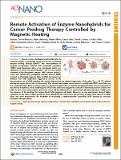Por favor, use este identificador para citar o enlazar a este item:
http://hdl.handle.net/10261/344372COMPARTIR / EXPORTAR:
 SHARE SHARE
 CORE
BASE CORE
BASE
|
|
| Visualizar otros formatos: MARC | Dublin Core | RDF | ORE | MODS | METS | DIDL | DATACITE | |

| Título: | Remote activation of enzyme nanohybrids for cancer prodrug therapy controlled by magnetic heating |
Autor: | Torres Herrero, Beatriz CSIC ORCID; Armenia, Ilaria CSIC ORCID; Alleva, María CSIC ORCID; Asín, Laura CSIC ORCID; Correa, Sonali; Ortiz, Cecilia; Fernández-Afonso, Yilian CSIC ORCID; Gutiérrez, Lucía CSIC ORCID; Fuente, Jesús M. de la CSIC ORCID; Betancourt, Lorena; Grazú, Valeria CSIC ORCID | Palabras clave: | Enzyme prodrug therapy Magnetic nanoparticles Biomimetic silica Nanohybrid Nanoactuation Remote enzyme activation Magnetic heating |
Fecha de publicación: | 2023 | Editor: | American Chemical Society | Citación: | ACS Nano 17(13): 12358-12373 (2023) | Resumen: | Herein, we have developed nanohybrids (nHs) to remotely activate a therapeutic enzyme for its use in Directed Enzyme Prodrug Therapy (DEPT). The coencapsulation of magnetic nanoparticles (MNPs) with horseradish peroxidase (HRP) using biomimetic silica as an entrapment matrix was optimized to obtain nanosized hybrids (∼150 nm) for remote activation of the therapeutic enzyme. HRP converts indole-3-acetic acid (3IAA) into peroxylated radicals, whereas MNPs respond to alternating magnetic fields (AMFs) becoming local hotspots. The AMF application triggered an increase in the bioconversion rate of HRP matching the activity displayed at the optimal temperature of the nHs (Topt = 50 °C) without altering the temperature of the reaction media. This showed that enzyme nanoactuation is possible with MNPs even if they are not covalently bound. After an extensive physicochemical/magnetic characterization, the spatial location of each component of the nH was deciphered, and an insulating role of the silica matrix was suggested as critical for introducing remote control over HRP. In vitro assays, using a human pancreatic cancer cell line (MIA PaCa-2), showed that only upon exposure to AMF and in the presence of the prodrug, the enzyme-loaded nHs triggered cell death. Moreover, in vivo experiments showed higher reductions in the tumor volume growth in those animals treated with nHs in the presence of 3IAA when exposed to AMF. Thus, this work demonstrates the feasibility of developing a spatiotemporally controlled DEPT strategy to overcome unwanted off-target effects. | Versión del editor: | https://doi.org/10.1021/acsnano.3c01599 | URI: | http://hdl.handle.net/10261/344372 | DOI: | 10.1021/acsnano.3c01599 | E-ISSN: | 1936-086X |
| Aparece en las colecciones: | (INMA) Artículos |
Ficheros en este ítem:
| Fichero | Descripción | Tamaño | Formato | |
|---|---|---|---|---|
| remoteheating.pdf | 8,3 MB | Adobe PDF |  Visualizar/Abrir |
CORE Recommender
PubMed Central
Citations
3
checked on 26-abr-2024
SCOPUSTM
Citations
5
checked on 24-abr-2024
WEB OF SCIENCETM
Citations
4
checked on 22-feb-2024
Page view(s)
13
checked on 28-abr-2024
Download(s)
16
checked on 28-abr-2024

